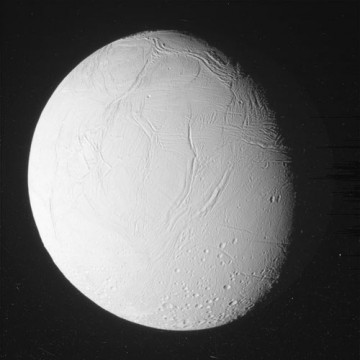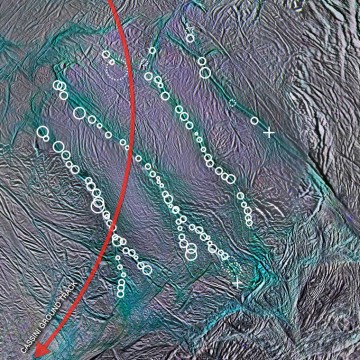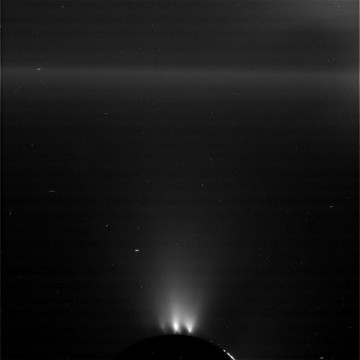The spacecraft has taken its deepest dive through the water plume leaking from the subsurface ocean of Saturn's moon Enceladus.

NASA / JPL-Caltech / Space Science Institute
On October 28th, the Cassini spacecraft took its deepest dive through the water plume spewing from the south pole of Saturn’s moon Enceladus. It passed only 30 miles (50 kilometers) above the icy surface.
Although the spacecraft has come closer to the moon before — the closest pass was a mere 15 miles up — it’s never passed this directly through the plume before.
Cassini has been on a merry jaunt through the Saturn system for 11 years now. It discovered Enceladus’s marvelous southern plume soon after its arrival. The spritz reaches thousands of miles into space, released from cracks in the moon’s crust called tiger stripes. The material sprayed out is a combination of water and organics, pulled from a subsurface ocean that scientists now think extends globally. The ocean lies maybe 10 to 15 miles below the crust and reaches depths of 30 miles beneath the surface.
The plume’s composition implies there’s hydrothermal activity at work deep inside Enceladus, too, perhaps like that seen on Earth’s ocean floor.

NASA / JPL-Caltech / Space Science Institute
Cassini whizzed over the moon’s surface at 19,000 mph (8 km per second), taking only tens of seconds to complete the pass. That’s too fast to carefully focus on the surface, so instead the team left the apertures of the narrow- and wide-angle cameras open, “shuttering like mad,” said project manager Earl Maize (JPL) in a preview October 26th press briefing. The spacecraft’s trajectory took it right over one of the dozens of active regions found along the tiger stripes, as shown in the diagram at right.
During this flyby Enceladus’s south pole was in shadow, so Cassini saw the surface in saturnshine.
As project scientist Linda Spilker (JPL) explained during the briefing, the team was looking for three things during this flyby:
- How much molecular hydrogen is in the plume. More molecular hydrogen means more hydrothermal activity.
- The plume’s chemical composition.
- Does the plume come from discrete jets from the moon’s surface, or is the release more like a “curtain” along the full extent of the tiger stripes? The difference matters in that it reveals how the subsurface ocean is connected to the surface — are there individual conduits, or an open crack that goes right into the ocean? That might also tell us how much thermal energy is coming out of fractures.
Although the images are out now, the initial look at these other measurements will take about a week (probably for the Division of Planetary Sciences meeting in mid-November), with more detailed analysis after that.
Fun fact: the amount of plume vapor that Cassini encountered to make all these measurements is equivalent to only a tiny drop of water.
The Final Act

NASA / JPL-Caltech / Space Science Institute
This flyby was the 21st the spacecraft has made of Enceladus during its mission. It has one more scheduled, in December. After that Cassini will say goodbye to the little moon and enter the final act of its mission. It’ll visit some of Saturn’s ring moons and take a close look at the rings themselves.
Then in April 2017 the spacecraft will dive through the 1,200-mile gap between the innermost ring and the top of Saturn’s atmosphere. It will spend 22 orbits here, looking at the planet’s magnetic field, measuring the mass of the rings and the composition of both ring particles and the upper atmosphere. Then finally, propellant at its end, it’ll plunge into Saturn’s atmosphere and vaporize.
NASA’s put together an Enceladus Final Flybys Toolkit, check it out for more information
 1
1









Comments
Michael Gerver
November 13, 2015 at 6:25 am
All this is very interesting, but doesn't tell us what we most want to know--does Cassini have instruments that could analyze the plume to find signs of life in the ocean? I'm not expecting that the plume coughed up whole frozen fish, or even bacteria, but maybe it includes organic molecules that are too complicated to have been produced except by living organisms? Such as proteins or bits of DNA, or whatever the Enceladans use instead? Did Cassini look for anything like that?
You must be logged in to post a comment.
You must be logged in to post a comment.